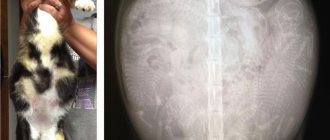Quite an exciting event for a breeder - everyone needs to know how a cat is about to give birth and how to take care of it and how to care for a pet after lambing. During labor, various problems may arise; you need to be prepared for this. In what cases can you handle it yourself, and when you need the help of a veterinarian, read on.
Pregnant cat
How to prepare for a cat giving birth
You need to prepare for lambing in advance, before the cat herself has set up a nest somewhere in the closet or under the bed. If this happens, it will be inconvenient to care for a mother with children. About 2-3 weeks before the expected date of birth, you need to arrange a cozy place where the babies will be born.
You can use various objects as a nest. The main thing is that the whole cat family can stay there. Let's consider several options:
- a spacious cardboard box or box with several ventilation holes;
- a special birth box, which is sold in pet stores;
- a small children's play tent in the form of a house or cube.
Requirements for the nesting area - free access from above, the presence of an entrance for the cat. It should be located at a height of 10 cm from the floor so that the kittens cannot go outside on their own. You need to put oilcloth inside, and a clean old sheet or unnecessary rags on top.
Attention! You cannot use newspapers, cotton wool, or fabrics with frayed edges as bedding - kittens can get tangled in the threads and suffocate.
The box is placed in a dark place in the apartment, protected from drafts. It is advisable to place it where household members are least likely to visit. The room should be warm, but not stuffy.
Show the expectant mother a ready-made nest for lambing, let her sniff everything and lie there. If you notice that closer to the birth the cat is trying to arrange another place, it is better to move the box there.
Preparing the birth place
By calculating how many months your cat will give birth, you can prepare a mini-maternity hospital in advance. It can be a small box with slots for air, closed, darkened and with soft bedding. About a day before giving birth, the cat begins to look for a cozy nest, gets worried, and also demands double affection and attention from you.
The most favorite places for lambing are linen closets, dresser drawers, with warm clothes. The most important thing is that the place is cozy and smells like the owner. The ideal option is a bed, which is why so often the owners wake up in the morning with the whole family. Even after giving birth in another place, the cat strives to move the newborns closer to the person.
To prevent this from happening, prepare the box in advance. Be prepared for the fact that when the cat feels the first contractions, it will try to be on your lap, so she will not want to sit in her box alone. Before the birth of the first kitten, it is better to spend time with your pet, pet and calm her. If birth occurs at night, you risk waking up to the sound of your babies squeaking in your bed.
Signs of approaching and onset of labor
The duration of pregnancy in cats is 57–70 days. At about 7–9 weeks, you can already see the kittens moving when the pet is resting. The upcoming onset of labor can be judged by the behavior of the animal. Signs that lambing is approaching are:
- anxiety, restlessness, the expectant mother may avoid communicating with people or require more attention;
- the cat pulls out hair in the area of the mammary glands;
- loss of appetite;
- frequent urination;
- redness of the external genitalia (observed 1–2 days before birth);
- discharge of colostrum from the nipples;
- discharge of the mucus plug;
- a few hours before the onset of labor, anxiety intensifies, the cat goes to the nest;
- body temperature drops to 37 degrees;
- the animal takes a characteristic pose - arches its back, as if hunched over;
- shortly before birth, the animal's nose and ears become hot.
The cat's mucus plug came off
Soon contractions begin. The stomach periodically tenses and then relaxes. Then the amniotic fluid usually leaves. As a rule, the first kitten emerges from the reproductive tract within 1–2 hours, but each case is individual.
What will you need during childbirth?
Not every cat may need help with lambing. Animals usually cope on their own, but human presence is still necessary to monitor whether everything is going well. Having discovered signs of approaching labor, you need to prepare materials and tools:
- clean diapers or towels;
- gloves;
- a syringe to remove mucus from the nose of newborn kittens;
- threads for tying the umbilical cord;
- scissors (sterilize);
- petrolatum;
- waste container;
- greenery.
The owner of the animal must have medications at his disposal, thanks to which the birth will take place without complications. These include:
- Gamavit. They begin to use it 5–7 days before the expected date of birth of the kittens. Used as subcutaneous injections 1 time per day, 1 ml. Also, the injection is given immediately after the start of contractions. Gamavit is given to kittens immediately after birth (3 drops in the mouth) and over the next 3 days, once a day.
- Calcium gluconate. During labor and after birth, the cat is injected with 1–2 ml under the skin in the withers area. This will prevent eclampsia.
- Oxytocin. Used to stimulate labor if contractions suddenly stop. The medicine is administered subcutaneously. Dosage – 0.3 ml. The hormonal drug can only be used on the recommendation of a veterinarian.
- Mastomethrin. A medicine that prevents the development of mastitis after childbirth. The drug is administered intramuscularly in a dosage of 0.5–1 ml once a day for 3 days.
When to expect kittens
It is important not only to know how a cat behaves before giving birth and what is happening in its body, but also to roughly navigate the potential dates for the birth of kittens. For this, there is a special calendar, according to which you can determine the approximate day of birth of kittens, knowing the date of conception.
To determine the approximate period when you need to start expecting kittens and pay attention to the behavior of a pregnant cat before giving birth, you can use a special calculator table.
The first column contains the date of conception (accurate or estimated), next to it will be the estimated date of birth. Give or take a few days and the entire period will be outlined when the owner should begin to pay attention to the pet’s behavior and special symptoms - precursors. For example, if conception occurred on April 12, then around June 16 you need to expect kittens (plus or minus a few days). If a cat was mated with a male on September 8, then kittens may appear within November 12.
How do first and subsequent births happen in cats?
There is no need to worry if your cat is giving birth for the first time. Although the animal does not have experience in giving birth, thanks to the instincts inherent in nature, the process will proceed normally if the expectant mother is healthy. The owner only needs to be nearby and control the situation. It is important to understand what is the norm and what is a deviation.
Newborn kitten
Childbirth in cats occurs in 3 stages:
- Contractions and uterine contractions begin. The interval between them gradually decreases. At this time, the cervix opens.
- Then the pushing begins - the first kitten moves along the birth canal towards the exit. The abdominal muscles tense strongly to push the fetus out. The second stage can last from 10 minutes to an hour. After the birth of the first kitten, the cat bursts the bladder, gnaws the umbilical cord and licks the baby. The next kittens are born, as a rule, at intervals of 10–50 minutes.
- After every baby is born, the placenta must come out. It is important to carefully monitor how much afterbirth has separated. Your cat will need veterinary attention if the placenta remains inside, as it will begin to decompose and cause severe inflammation.
Attention! Cats often eat the afterbirth, so the owner needs to be nearby so as not to miss this moment.
The average duration of labor for a cat is 5–8 hours. There are 2–4 kittens in one litter. In some cases, 5–6 cubs are born.
General information
First you need to find out where these fluid flows that accompany the birth of kittens (and other mammals too) come from. In general, the so-called “water” is the contents of the amniotic sacs, in which each kitten is “wrapped” during growth and development in the uterus. This liquid is extremely. The sac is formed by two membranes called amnion and chorion. We are only interested in the amnion, since it is the aqueous membrane (which is removed during any normal childbirth).
Childbirth started prematurely
If the cat’s labor began 3-5 days earlier, there is nothing to worry about. Gestation periods differ for different breeds. Thus, pregnancy in Siamese cats lasts approximately 70 days, and for some elite breeds the norm is to lamb on the 55th day of gestation, although it is believed that cubs born before the 60th day are not viable.
Causes of premature birth in cats:
- fear, stress;
- intrauterine infections;
- fall, blow to the stomach;
- fetal freezing;
- placental abruption.
Attention! If your cat's contractions begin prematurely, it is better to invite a veterinarian or take the animal to the clinic. Using an ultrasound, you can determine whether the kittens are alive in the womb and whether labor needs to be stopped or not.
How to deliver a cat at home
Typically, the birth of kittens does not require human intervention. It is enough for him to observe the process. An easy birth is when everything happens naturally and without complications. If the fetus comes out in a bubble, it is necessary to break it in the head area and free the baby.
The umbilical cord connects the kitten to the afterbirth
It happens that the kitten is not breathing, then you need to clean the nose and mouth with a rubber bulb. If this doesn't help, turn your baby upside down and shake him lightly until he squeaks. Next, the body is wiped with a clean cloth. The umbilical cord is tied with thread and cut with scissors with sterile blades, 2 cm away from the place of constriction on the side of the placenta. Then the kitten is given to its mother.
This is what they do with all other kids. At the end of labor, it is important to make sure that the same amount of placenta is released as kittens were born. If the placenta does not come out within a few hours, you should take your cat to the vet.
In rare cases, it happens that a kitten gets stuck in the birth canal. This is very dangerous as he could die. It is important to help your pet push it out as quickly as possible. To do this, Vaseline is applied to the animal’s genitals. If this does not help, then put on a fingertip or a sterile glove, lubricate the index finger and carefully insert it into the cat’s vagina, thereby changing the position of the fetus. The baby should not be pulled by the paws so as not to injure him. You can take him by the shoulders and turn him a little. After waiting for the next attempt, the fetus is carefully pulled out.
The kittens were just born
Possible problems after giving birth to a cat
It is important to monitor the woman in labor, noting any changes in her condition and behavior. When you need veterinary help:
- if the kitten is stuck in the birth canal and does not come out;
- the cat started bleeding;
- the afterbirth remained inside;
- after the end of childbirth, the cat still has a large and hard belly;
- the pet does not eat or drink;
- the new mother has started to have convulsions and is drooling;
- the temperature has risen;
- contractions last for several hours, but the cat does not give birth.
Having discovered such symptoms, you should not hesitate. Complicated childbirth can lead to the death of your pet.
Behavior
It is very important to closely monitor the pregnant woman during the expected dates of birth of the kittens. A cat's behavior before giving birth can be the most unpredictable, but quite typical. An attentive owner will always notice prenatal changes.
May be:
- almost constant purring and following on the heels of the owner. Murka literally requires increased attention;
- a clear call to follow her to the place where she is expected to give birth;
- when the due date approaches, try to find a secluded place and hide there, if a special place has not been equipped before this moment;
- for 10-12 hours, sitting without leaving in a place prepared by a person for newborns, it is impossible to call Murka from there;
- the cat looks tired, detached, and often does not eat anything;
- almost constantly licks his genitals;
- constantly lies down, but at the same time turns over from side to side, as if he cannot find a comfortable position;
- when meowing and attracting attention, it can look back at its stomach and show that something is starting (this is noticeable only to very attentive owners).
Postpartum care
After giving birth, the mother cat licks her babies and eats the placenta. It contains many vitamins. Veterinarians do not recommend allowing your pet to eat more than two afterbirths.
Mommy needs peace and good care. The most important thing is to monitor the condition of your nipples. Hardening in the mammary gland is a sign of the development of mastitis. If you find lumps or reddening of the nipples, you need to contact a veterinarian.
The cat must receive adequate nutrition. It is recommended to give her special food for lactating animals. It is easily digestible and contains all the necessary components. Kittens stay with their mother until they are ten weeks old. After 14–15 days, their eyes open, then the babies begin to explore the world around them.
Delivering a cat's birth is not that difficult. The main thing is not to panic and prepare in advance everything you might need if problems arise during the process. In most cases, human participation is not required; animals act instinctively. However, representatives of artificially bred breeds sometimes have complications during childbirth.











